For many years the Villa was above all a hospital.
During the winter of 1887-88 some of the most authoritative members of the local German colony met in committee to raise funds to build a small hospital where resident countrymen and those passing through in need of care could find a family environment and care carried out exclusively by German doctors and nurses.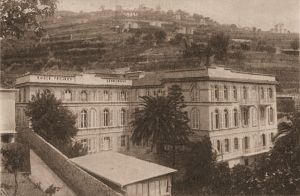 The subscriptions, enriched by substantial oblations from the Emperor Frederick of Germany, who had been staying in San Remo for some time for health reasons, from Princess Elisabeth of Mecklemburg- Schwerin, other personalities of the German ruling house, as well as from the wealthy Germans living in San Remo and partly from Germany itself, where publicity had been given in this regard, were so numerous that the Chairman of the Promoting Committee, Dr. K. Schwerin, was appointed by the Committee. Giorgio Goltz was soon able to purchase the Villa Maddalena in the region of Peirogallo, which was the first nucleus of the building of the hospital, which was named after Emperor Frederick, courtesy of the Empress of Germany.
The subscriptions, enriched by substantial oblations from the Emperor Frederick of Germany, who had been staying in San Remo for some time for health reasons, from Princess Elisabeth of Mecklemburg- Schwerin, other personalities of the German ruling house, as well as from the wealthy Germans living in San Remo and partly from Germany itself, where publicity had been given in this regard, were so numerous that the Chairman of the Promoting Committee, Dr. K. Schwerin, was appointed by the Committee. Giorgio Goltz was soon able to purchase the Villa Maddalena in the region of Peirogallo, which was the first nucleus of the building of the hospital, which was named after Emperor Frederick, courtesy of the Empress of Germany.
Once the villa had been restored, Goltz obtained authorisation from the Prefect of Porto Maurizio to open « a Hospital with the prefixed aim of welcoming sick people of both sexes and for all illnesses in the Foreign Colony of San Remo and other places in the surrounding area, both free of charge and against payment ».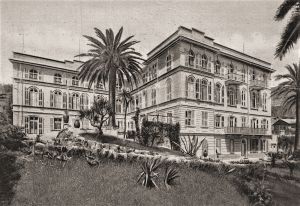 The hospital was inaugurated on 1st December 1890 and was increasingly lucky thanks to the influx of foreigners into Italy, while Italian citizens, by law, could not be treated by the German doctors of the hospital. The carefully administered Kaiser Friedrik Ffrankenhaus always functioned as a private nursing and rest home at certain rates, and over time it was able to expand and introduce modern innovations.
The hospital was inaugurated on 1st December 1890 and was increasingly lucky thanks to the influx of foreigners into Italy, while Italian citizens, by law, could not be treated by the German doctors of the hospital. The carefully administered Kaiser Friedrik Ffrankenhaus always functioned as a private nursing and rest home at certain rates, and over time it was able to expand and introduce modern innovations. 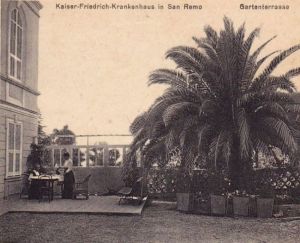 It is very interesting and also controversial the exact definition of the character of the Institute in question and its legal position before the Italian government. (on the basis of the documents preserved in the archives of the German hospital, it was possible to make a reconstruction which, at the moment, goes beyond these brief notes ...).
It is very interesting and also controversial the exact definition of the character of the Institute in question and its legal position before the Italian government. (on the basis of the documents preserved in the archives of the German hospital, it was possible to make a reconstruction which, at the moment, goes beyond these brief notes ...).
During the First World War the Emperor Frederick Hospital was requisitioned by the Italian Government, as an asset of enemy subjects and only a few years after the end of the conflict the Germans obtained the restitution of the building with various impositions, first of all the one that 20% of the places were free of charge, or with reduced payment, had to be reserved to poor, not chronic, natives of Sanremo, and generally Italian citizens.
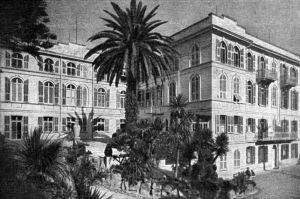
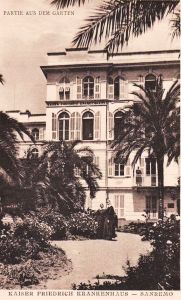 Returned in the hands of the owner company with a deed of restitution dated 18 June 1925, the building was refurbished, equipped with all the comforts necessary for a modern clinic and reopened to the public: the management, rather than as before to free German nurses, was entrusted to the Sisters Diaconesses of Kaiserwert, highly esteemed in Germany for their caring and administrative skills.
Returned in the hands of the owner company with a deed of restitution dated 18 June 1925, the building was refurbished, equipped with all the comforts necessary for a modern clinic and reopened to the public: the management, rather than as before to free German nurses, was entrusted to the Sisters Diaconesses of Kaiserwert, highly esteemed in Germany for their caring and administrative skills.
The Italian clientele had gradually increased and came to represent a good asset for the hospital, so the property was adapted to hire an Italian doctor for internal services and to allow any Italian professional who wished to do so, to treat their patients in the Kranhenhaus as in a private clinic.
The last documents concerning the Emperor Frederick Hospital date back to 1942, when the Deaconesses left San Remo to take refuge in Germany, taking with them everything that could be removed. The hospital was closed and left to the care of the caretakers.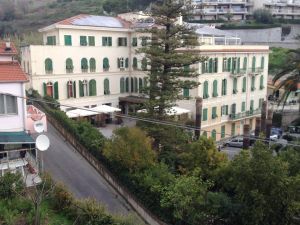 At the end of the war, the German hospital Emperor Frederick, seriously damaged by the bombardments, which had already been requisitioned by the Italian Government as an asset belonging to the enemy, was entrusted to the protection of the civil hospital of Sanremo, which stipulated a long-term lease with a company willing to take on the costs of reconstruction and rehabilitation for the functioning of the Institute.
At the end of the war, the German hospital Emperor Frederick, seriously damaged by the bombardments, which had already been requisitioned by the Italian Government as an asset belonging to the enemy, was entrusted to the protection of the civil hospital of Sanremo, which stipulated a long-term lease with a company willing to take on the costs of reconstruction and rehabilitation for the functioning of the Institute.
The institute later took the name of Villa Speranza and functioned as a private nursing home where surgery could also be carried out, (eminent surgeons operated there: Prof. Battezzati, Prof. Paletto and Prof. Cazzaniga among others) treated patients, performed surgery and there was also a birthplace until the early 90s.
The rest is recent history: it is currently used as a rest home for the elderly.
(sources: text Andrea Gandolfo; private images)




